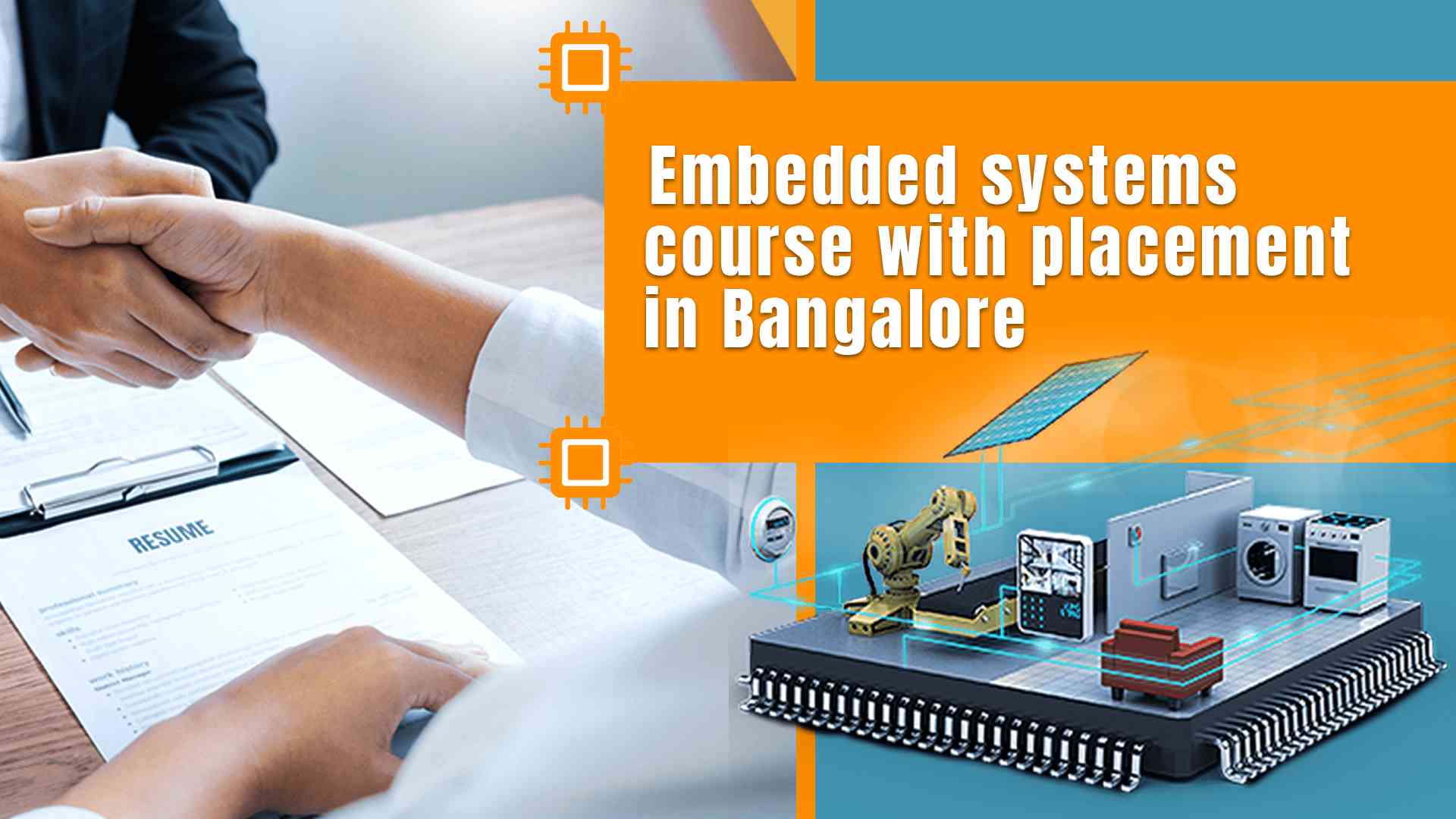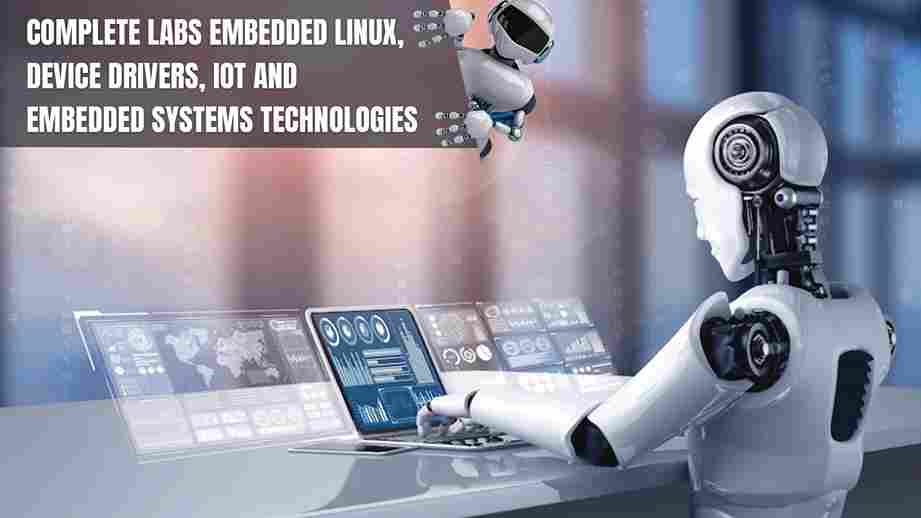EmbisysLabs is one of the best Embedded Systems training institutes in Bangalore with placement support. We provide industry-standard courses in rapidly evolving technologies such as Embedded Systems, Embedded C Programming, Linux Device Drivers, Internet of Things (IoT), ARM, Cortex-M4, Beaglebone, ARM9, and Raspberry Pi.Our courses are specifically designed to upskill working professionals and engineers from diverse backgrounds. For freshers, we provide the knowledge and practical experience required to become industry-ready Embedded Systems professionals, helping them secure placements in core embedded companies.The combination of Embedded Systems, IoT, and kernel programming, along with our ‘Learning by Doing’ methodology, ensures exponential learning and hands-on experience, far beyond conventional training methods in bengaluru India.
A Complete Guide to a Career with EmbisysLabs Embedded Systems Training in Bangalore
Embisyslabs offer practical oriented embedded systems courses in Bangalore for freshers and professionals. Embedded systems serve as a bridge between traditional hardware and software.With artificial intelligence, edge computing and other advancements, the embedded systems are experiencing meteoric growth with many vast fields. This course help to gain some important perspectives about this field. Knowing programming languages such as C or C++ or Embedded C to be used in Embedded systems is enough,especially if you are not working on RTOS.Many professionals working in this field of embedded systems conform this thesis.
The Key to Reliable and Optimized Embedded Systems Design with Placement in Bangalore- Embisyslabs
Built on an open-source Linux platform, EmbisysLabs Embedded Systems and IoT courses provide an immersive and hands-on learning experience for all participants.With over 10 years of excellence, we have established ourselves as one of the top Embedded Systems training institutes in India.Our courses are known for their practical learning approach, industry-standard curriculum, flexible schedules, and unlimited placement support. These are the key reasons why students choose our Embedded Systems courses with placement opportunities.

MODULE WILL BE COVERED IN EMBEDDED SYSTEM AND EMBEDDED LINUX FOR WORKING
C, D.S, Embedded C on Arm7, Linux Programming, IPC, Kernel porting on Cortex-A8 and Character Device Driver
5 to 6 Months
3-4 hours/day
45 Thousands
Freshers/Working
Class Room

MODULE WILL BE COVERED IN EMBEDDED SYSTEMS AND LINUX PROGRAMMING FOR FRESHERS
C, D.S, C++ Programming,Embedded C on Arm7,Linux Programming, IPC, Character Device Driver
5 to 6 Months
3-4 hours/day
45 Thousands
Freshers/Working
Class Room

MODULE WILL BE COVERED IN LINUX DEVICE DRIVERS FOR WORKING PROFESSIONALS
Character, Block, USB host & gadget, PCI, Network, I2C and SPI Device Drivers
3 to 4 Months
4-5 hours/day
55 Thousands
Freshers/Working
Class Room

MODULE WILL BE COVERED IN EMBEDDED AND DEVICE DRIVERS
C, Embedded C, Arm7, Beaglebone Cortex-A8, Linux Program, Kernel program, Character, Block, USB Host & Gadget, PCI, Network, I2C and SPI Drivers
6 to 7 Months
4-5 hours/day
85 Thousands
Freshers/Working
Class Room
Why Embedded Systems Training and Courses in Embisyslabs
Get Trained, Get Interviewed and Get Employed.Training Courses as per Company Requirements.
More Updated Syllabus,Unlimited Practical.
Training as per Company Requirements.
Internal Assessments, Mock Interviews.
Maximum 10 Participants in one Batch.
Indivisual Attention to each Participant.
High Quality practical/application Oriented Training.
Training and Practicals Process
Classes 5-Days a week for Weekdays BatchTheory( 2 hrs) and practical (3 hrs.)
Classes 2 Days for Weekend Batch(Sat & Sun)
Theory(3 hrs) and practical (4hrs.)
Daily theory and lab assignments.
Module wise theory and lab exams.
Module wise Subjective exams.
Module wise Objective exams. Interviews & Project Guidance.
Repeatation classes will be conducted as required.
MODULE 1: C AND DATA STRUCTURE PROGRAMMING
CH1. GETTING STARTED
Why C Programming LanguageHistory & Features of C
Compilation Model of C
Compiler,Assembler,Linker
How to Compile & Run a C program
Strategy of Desinging a Program
CH2. FUNDAMENTALS OF PROGRAMMING
Variables & ConstantsKeywords & Data Types
Identifires & Rules
I/O Functions
CH3. OPERATORS AND CLASSIFICATIONS
Arithmetic OperatorsBitwise Left shift
Right shift Ternary
Logical AND OR NOT
Increment Decrement
Relational Conditional
CH4. CONTROL FLOW STATEMENTS
Sequential statementsDecision making statements
if,else,nested-if
break,switch
CH5. LOOPING STATEMENTS
For LoopingWhile Looping
Do—While Looping
Continue Looping
CH6. C PRE-PROCESSOR
File inclusionMacro substitution
Conditional Compilation
#ifde, #ifndef
CH7. ARRAYS AND STRING
Definition and Description of ArrayDeclaration and details about String
Memory Layout &accessing Array Elements
String Library Functions
Two dimensional Arrays
CH8. POINTERS [PART 1]
Definition &Declaration of PointerIndirect Access using Pointers
Pass by Reference
Rela. b/w Arrays and Pointers
Type Casting
Pointer to an Array
Array of Pointers
CH9. FUNCTIONS AND ITS TYPE
Why Functions ?Function Declarations
Function Prototypes
Returning a Value or Not
Arguments and Parameters
Function Pointers
Recursion and Recursive function
CH10. SCOPE and LIFETIME OF VARIABLES
Scope and Lifelime of a variableBlock Scope
Function Scope
File Scope
Program Scope
The auto Specifier
The static Specifier
The register Specifier
The extern Specifier
The Const Modifier
The Volatile Modifier
CH11. POINTERS AND POINTER ARRAY[PART 2]
Dynamic Storage Allocationmalloc(),calloc(),realloc(),free()
Functions Returning a Pointer
An Array of Character Pointers
Two Dim.Arrays vs. Array of Pointers
Command Line Arguments
Pointers to Pointers
Use of Function Pointers
CH12. SERCHING &SORTING
Linear Search&Binary SearchBubble sort & Selection Sort
CH13. STRUCTURES PROGRAMMING
Fundamental ConceptsDescribing a Structure
Creating Structures
Operations on Structures
Functions Returning Structures
Passing Structures to Functions
Pointers to Structures
Array of Structures
Functions Returning a Pointer to a Structure
Structure Padding
# pragma Definition
CH14: STRUCTURE RELATED (UNION)
Typedef - New Name for an Existing TypeBit Fields - Memory saving concept
Union - emory saving concept
Enumerated User Defined Data Types
CH15. FILE HANDLING AND INPUT/OUTPUT
I/O Library FunctionsSystem Calls vs. Library Calls
High and Low level I/O Functions
I/O Library Functions
Standard Input/Output Descriptors
fopen(),fread(),fwrite(),fclose()
Copying a File
Character Input vs. Line Input
fscanf(),fprintf(),fclose()
fgtes(),fputs(),fgetc(),fputc()
MODULE 2: DATA STRUCTURE USING C PROGRAMMING
CH1: INTRODUCTION TO DATA STRUCTURE
Why data structure ?Definition and Classification
CH1: STACK PROGRAMMING
What is Stack?Push operatins insert an item from top end of Stack
Pop operatins delete an item from top end of Stack
Implementation of Stack using Array Pointer
Implementation of Stack using Pointer
CH1: QUEUE PROGRAMMING
What is Queue?Insert an item from front end of Queue
Delete an item from rear end of Queue
Implementation of Queue using Array Pointer
Implementation of Queue using Pointer
CH1: LINK LIST PROGRAMMING
Singly link listsCircular link lists
Double link list
Implement Below Assignment for All types of Link List
Insert an item from Front End of Link List
Insert an item from Rear End of Link List
Insert an item at Specific Postion of Link List
Delete an item from Front End of Link List
Delete an item from Rear End of Link List
Delete an item at Specific Postion of Link List
Reverse the link list
Find the middle node of link list
C and Data Structures Hands-on in Class Room
1. Hundred Subjective Questions in C and Data Structure Programming2. Hundred Objective Questions in C and Data Structure Programming
3. Two Mini Projects on C and Data Structure Programming Modules
4. Class Room Test based on C and Data Structure Programming Modules
MODULE 3: C++ and OBJECT ORIENTED PROGRAMMING(OOPs)
CH1. GETTING STARTED WITH C++
Why C ++ Programming LanguageHistory & Features
Compilation Model
How to Compile & Run a C program
Strategy of Desinging a Programming
Introduction and First Program
How C++ differs from C
CH2. FUNDAMENTALS OF PROGRAMMING
Variables & ConstantsKeywords & Data Types
Identifires & Rules
I/O Functions
CH3. BASIC INPUT/OUTPUT
I/O Library Header FilesThe Standard Output Stream (cout)
The Standard Input Stream (cin)
The Standard Error Stream (cerr)
The Standard Log Stream (clog)
CH4. OPERATORS AND CLASSIFICATIONS
Arithmetic OperatorsBitwise Operators
Logical Operators
Increment Operators
Decrement Operators
Relational Operators
Conditional Operators
CH5. CONTROL FLOW STATEMENTS
Sequential statementsDecision making statements
if,else,nested-if
break,switch
CH6. LOOPING STATEMENTS
For LoopingWhile Looping
Do—While Looping
Continue Looping
CH7. ARRAYS AND STRING
Definition and Declaration of ArrayDefinition and Declaration of String
Memory Layout &accessing Array Elements
String Library Functions
Two dimensional Arrays
CH8. FUNCTIONS AND ITS TYPE
Why Functions ?Function Declarations
Function Prototypes
Returning a Value or Not
Arguments and Parameters
Function Overloading
Defaut Function
Inline Functions
CH9. DYNAMIC MEMORY ALLOCATION
The new and delete OperatorsDynamic Memory Allocation for Arrays
Dynamic Memory Allocation for Objects
CH10. CLASSES AND OBJECTS
C++ Class DefinitionsDefine Objects
Accessing the Data Members
Classes & Objects in Detail
Class Access Modifiers
The public Members
The private Members
The protected Members
CH11. CONSTRUCTOR AND DESTRUCTOR
Constructor & Destructor RulesDefault Constructor
Parameterized Constructor
Copy Constructor
Constructor Overloading
The Class Destructor
Friend Functions
CH12. C++ POLYMORPHISM
What is PolymorphismPure virtual functions
Virtual Base Class
CH13. C++ INHERITANCE
Base & Derived ClassesAccess Control and Inheritance
Type of Inheritance
Multiple Inheritance
CH14. OVERLOADING (OPERATOR & FUNCTION)
Operators Overloading in C++Overloadable/Non-overloadable Operators
Operator Overloading Examples
Unary Operators Overloading
Increment (++) and Decrement (--) Operators
Binary Operators Overloading
Relational Operators Overloading
Assignment Operators Overloading
CH15. C++ FILES AND STREAMS
What is a stream?Opening File
Closing File
Writing to a File
Reading from a File
Read & Write Example
File Position Pointers
C++ and Object Oriented Programming Hands-on in Class Room
1. Hundred Subjective Questions in C++ and Object Oriented Programming2. Hundred Objective Questions in C++ and Object Oriented Programming
3. Class Room Test based on C++ and Object Oriented Programming Modules
MODULE 4: ARM7TDMI-S and EMBEDDED C PROGRAMMING
Chapter1. Introduction to ARM Processor
Intro. to Cortex-A and Cortex-M Series ControllerWhy Embedded C Programming
Why Assembly Programming
Difference betwwen C And Embedded C Programming
Chapter2.Programming Environment Setup and Its Use
IDE installation (Keil uVision / ARM GCC)Downloading and installation of IDE, Flash Magic
Setting up hardware (development board)
Chapter3. Introduction to ARM Architecture[LPC2148 ]
Overview of ARM7 architectureFeatures of LPC2148 microcontrollers
Pin configuration and pin descriptione
Memory map of LPC2148
Flash memory and RAM details
Internal block diagram and functional overview
Chapter4. LPC2148 GPIO Programming
Understanding ports and pinsConfiguring pins as input/output
Pin Function Select Registers
Fast and Slow GPIO Registers
IOxPIN (GPIO Port Pin value register)
IOxSET (GPIO Port Output Set register)
IOxDIR (GPIO Port Direction control register)
IOxCLR (GPIO Port Output Clear register)
Chapter5. LPC2148 Interrupts and Interrupt Handling
Interrupt controller in LPC2148Configuring and enabling interrupts
Writing ISR (Interrupt Service Routine)
Fast IRQ (highest priority)
Vectored IRQ (medium priority)
Non-Vectored IRQ (low priority)
Chapter6. LPC2148 Timer/Counter
Timer features in LPC2148Timer Counter(TC) and Prescale Register(PR)
What is a Match Register
What are Capture Registers
Prescale (TxPR) Related Calculations
Setting up & configuring Timers
Chapter7. LPC2148 UART[Universal Asynchronous Receiver/Transmitter]
Difference between UART/USARTUART module overview
UART Frame structure
UART Baudrate Calculation
Sending and receiving data using UART
U0RBR (UART0 Receive Buffer Register)
U0THR (UART0 Transmit Holding Register)
U0DLL and U0DLM (UART0 Divisor Latch Registers)
U0LCR (UART0 Line Control Register)
Chapter8. LPC2148 ADC[Analog to Digital Converter] :
ADC features in LPC2148ADC0 has 6 channels &ADC1 has 8 channels
Steps for Analog to Digital Conversion
ADxGDR (ADCx Global Data Register)
AD0STAT (ADC0 Status Register)
ADxCR (ADC Control Register)
Chapter9. LPC2148 PWM[Pulse Width Modulation programming]
PWM functionality and applicationsLPC2148 supports 2 types of PWM
7 match registers inside the PWM block
Configuring and Initializing PWM
PWM Prescale (PWMPR) Calculations
DC Motor Speed Control Using PWM
LED Dimming Using PWM
Chapter10. LPC2148 I2C[Inter Integrated Curcuit]
I2C overviewI2C-Bus Configuration
I2C Operating modes
I2C Master Transmitter mode
I2C Master Transmitter mode
I2C Implementation and operation
I2C Register description
I2C Programming
Chapter11.LPC2148 SPI[Serial Peripheral Interface]
SPI overviewSPI data transfer format
SPI data to clock phase relationship
SPI Master operation
SPI Slave operation
SPI Register description
SPI Programming
Chapter12. Practical Applications and Projects
GPIO interfacing programmingInterrupt programming
Timers and Counter programming
Motor control using PWM
PWM Programming
Temperature Sensors Interfacing programming
Piezo Sensors Interfacing programming
Accelerometer Sensors Interfacingprogramming
LCD interfacing programming
Embedded C and ARM7 Hands-on in Class Room
1. All Peripherials Program with Keil C Simulator2. All Peripherials Program on ARM Board (LPC 2148)
3. Class Room Test based on Embedded C and ARM Architectures
MODULE 5: UNIX and LINUX SYSTEM PROGRAMING
CH1. INTRODUCTION TO UNIX/LINUX
Histoty of Unix/LinuxLinux Layered Architecture
Type of Kernels
Micro and Monolithic kernel
Different types of kernel structure
Linux Bootup Sequence
CH2. FILE SYSTEM MANAGEMENTS
File Systems – VFSFile Systems Layouts
Super Block & Inode Block
Inode block Structure
Device Special Files
Types of File
File descriptor table
System calls Sequence
System Vs Function Calls
File related System Calls
open(),read(),write(),close()
stat(),lstat(),dup() etc.
CH3. FILE LOCKING PROGRAMMING
File Control OperationsTypes of File Locking
Advisory and Mandatory File locking
fcntl() and flock()calls
CH4. PROCESS MANAGEMENTS
Program and ProcessProcess Control Block (PCB)
States Of Process
Mode of Execution User mode and Kernel mode
Context Switching
Scheduling & Priority
CH5. PROCESS RELATED PROGRAMMING
Process Creation by fork() amd vfork()Why fork() not vfork()
Creation and Destroying Zombie Process
Creation of Orphan Process
wait() and waitpid() calls
exit() and exec() ,sleep() calls
Creating , synchronizing and performing multiprocessing concepts
Setting and changing nice value and Prority no.
CH6:MEMORY MANAGEMENTS AND MMU
Memory Policy and HirarchyMemory allocation Technique
Physical memory &Virtual Memory
Paging & Demand paging
Memory Mapping using TLB
Swap in & Swap out
Internal & External Fragmentation
MODULE 6: LINUX INTERNALS AND IPCs PROGRAMMING
CH1. THREADS AND MULTI-THREAD CONCEPTS
Threads on different O.SWhy Threads in Linux
Threads Vs Process
Thread APIs
Creation of Multithreading
Performig Multiple operation using multi-threading
CH2. SIGNALS VS. INTERRUPTS
Sources of SignalsDiffrents type of Signals
Actions of Signals
Receiving a Signal
Handling a Signal
Signal System Calls
CH3. USER AND DAEMON PROCESS
Creating a Daemon ProcessCharacteristics of a Daemon
Writing and Running Daemon
CH4. PRIMITIVE INTERPROCESS COMM [IPCS]
PIPESCreation of Half and Full-duplex
Half and Full-duplex communication
FIFO
CH5. SYSTEMS V INTERPROCESS COMM [IPCs]
Shared MemoryMessage Queues
Semaphores
CH6 . NETWORK AND SOCKET PROGRAMMING
Description of ISO/OSI ModelTypes of IP Classes (A,B,C,D and E)
Configuring IP address on Systems
Network addresses and Host addresses
Types of Socket UDP Connectionless Oriented Socket
TCP/IP Connection Oriented Socket
Iterative Server-Client Programming
Concurrent Server- Client Programming
One Server and Many client Programming
Linux Systems and IPCs Hands-on in Class Room
1. Hundred Subjective Questions in Linux Systems Programming3. Two Mini Projects on Linux Systems Programming
4. Class Room Test based on Linux Systems Programming Modules
MODULE 7: LINUX CHAR DRIVER AND KERNEL PROGRAMMING
CH1: AN INTRO. TO DEVICE DRIVERS
Role of the Device DriversSplitting the kernel
Classes of devices and modules
Kernel Architecture or Model
CH2:BUILDING AND RUNNING MODULES
Types of Modules in the kernelWriting Your first kernel module
Module Related Commands
Kernel Module vs Applications
User space vs Kernel space
Compiling Modules
Loading and Unloading Modules
Module Parameters
CH3: CHAR DEVICE DRIVERS
Major and Minor NumbersThe Internal Representation of Device Numbers
Allocating and Freeing Device Numbers
File Operations Data structure
Driver methods and Function Pointers
Char Device Registration
The Cdev Structure
The inode Structure
The file Structure
Manual Ceation of Device Files
Automatic Creation of Device Files
CH4: MEMORY ALLOCATION TECHNIQUE
The Real Story of kmallocThe Flags Argument
Memory zones
kmalloc() and Vmalloc()
Device Driver Hands-on in Class Room
1. Subjective Questions in Linux Device Driver Programming2. Class Room Test based on Linux Device Driver Modules
✅ Course On Embedded C , LINUX, KERNEL AND ARM Design Programming
- The embedded c course has been specially designed for those who aspire to become ARM / Embedded C Programmimg and design engineer by the industrial experienced professionals.
- Each module will be taught in detail, which will help the participents to start working as Embedded engineer after the course completion.
- Much effort has been put into creating the syllabus, to cover the 'basics' for each module and then cover advanced Communication Protocols Peripherals topics UART, I2C, SPI,Interrupt along with the issues and resolving techniques practically.
- Embedded C course module will be taught in details, which will help the candidates to take up interviews and successive job and start working after the course completion.
-
Hardware-Level Access
Embedded C allows direct manipulation of hardware registers and peripherals, which is essential for low-level programming in embedded systems. -
Efficiency and Speed
Programs written in Embedded C are generally fast and efficient because they compile to compact machine code, enabling real-time system performance. -
Portability
Embedded C code can be written in a way that is portable across different microcontrollers and platforms, especially when hardware-specific code is isolated. -
Rich Language Features
Embedded C supports structured programming, data types, and operators that make code easier to write, understand, and maintain compared to pure assembly language. -
Wide Compiler Support
Most microcontroller manufacturers provide C compilers, making Embedded C a widely supported standard for embedded development. -
Easier Debugging and Maintenance
Compared to assembly, C code is easier to debug, maintain, and update, which reduces development time and effort. -
Code Reusability
Functions, libraries, and modules written in Embedded C can be reused in multiple projects, improving development efficiency. -
Better Integration with High-Level Applications
Embedded C can interface well with higher-level software modules and communication protocols, facilitating complex system designs. -
Branches: Electronics, Electrical, Computer Science, Mechatronics, Instrumentation.
-
Especially those in 2nd year and above who have basic C knowledge.
-
Final-year students doing embedded systems projects.
-
In related fields like Electronics, Electrical, or Embedded Systems.
-
Useful for practical, job-oriented training.
-
Engineers working in embedded systems, firmware, IoT, or hardware development.
-
Looking to upskill or switch to embedded roles.
-
Anyone interested in Arduino, Raspberry Pi, robotics, or DIY electronics.
-
Those building automation, sensor-based, or smart device projects.
-
Software developers (e.g., Python, Java, C++) wanting to transition into embedded software development.
-
People from testing, automation, or electronics hardware backgrounds.
-
Involved in embedded system research, IoT, or real-time systems.
-
Writing firmware or custom embedded solutions.
-
Familiarity with digital electronics and microcontroller basics.
-
Understanding of number systems (binary, hexadecimal) and logic gates is helpful.
✅ Here are some key advantages of Embedded C programming ?
✅ Who Can Learn Embedded C Programming?
1. Engineering Students
2. Diploma Holders.
3. Working Professionals.
4. Hobbyists and Makers.
5. Career Changers
6. Researchers & Postgraduate Students.
✅ Pre-requisites (Recommended)
- CH1. GETTING STARTED
- CH2. FUNDAMENTALS OF PROGRAMMING
- CH3. OPERATORS AND CLASSIFICATIONS
- CH4. CONTROL FLOW STATEMENTS
- CH5. LOOPING STATEMENTS
- CH6. C PRE-PROCESSOR
- CH7. ARRAYS AND STRING
- CH8. POINTERS [PART 1]
- CH9. FUNCTIONS AND ITS TYPE
- CH10. SCOPE and LIFETIME OF VARIABLES
- CH11. POINTERS [PART 2]
- CH12. SERCHING &SORTING
- CH13. STRUCTURES/a>
- CH14. STRUCTURE RELATED (UNION)
- CH15. FILE INPUT/OUTPUT
- CH16. DATA STRUCTURE USING C
- CH1. GETTING STARTED WITH C++
- CH2. FUNDAMENTALS OF PROGRAMMING
- CH3. BASIC INPUT/OUTPUT
- CH4. DYNAMIC MEMORY ALLOCATION
- CH5. CLASSES AND OBJECTS S
- CH6. C++ POLYMORPHISM
- CH7. C++ INHERITANCE
- CH8. OVERLOADING (OPERATOR & FUNCTION)
- CH9. C++ FILES AND STREAMS
- Chapter1.Introduction to ARM Processor
- Chapter2.Programming Environment Setup and Its Use
- Chapter3.Introduction to ARM Architecture[LPC2148 ]
- Chapter4. LPC2148 GPIO Programming
- Chapter5. LPC2148 Interrupts and Interrupt Handling
- Chapter6. LPC2148 Timer/Counter
- Chapter7. LPC2148 UART[Universal Asynchronous Receiver/Transmitter]
- Chapter8. LPC2148 ADC[Analog to Digital Converter]
- Chapter9. LPC2148 PWM[Pulse Width Modulation programming]
- Chapter10. LPC2148 I2C[Inter Integrated Curcuit]
- Chapter11.LPC2148 SPI[Serial Peripheral Interface]
- Chapter12. Practical Applications and Projects
- CH1. INTRODUCTION TO UNIX/LINUX
- CH2. FILE SYSTEM MANAGEMENTS
- CH3. FILE LOCKING PROGRAMMING
- CH4. PROCESS MANAGEMENTS
- CH5. PROCESS RELATED PROGRAMMING
- CH6:MEMORY MANAGEMENTS AND MMU
- CH1. THREADS AND MULTI-THREAD CONCEPTS
- CH2. SIGNALS VS. INTERRUPTS
- CH3. USER AND DAEMON PROCESS
- CH4. PRIMITIVE INTERPROCESS COMM (IPCS)
- CH5. SYSTEMS V INTERPROCESS COMM (IPCS)
- CH6. NETWORK AND SOCKET PROGRAMMING






